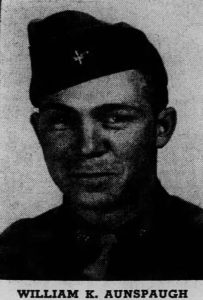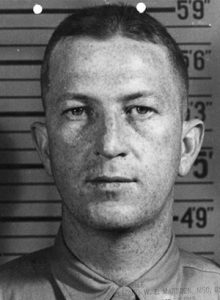Arthur L. Kautz, age 34, from Pennsylvania, Monroe county.
Service era: World War II
Date of death: Thursday, October 12, 1944
Death details: Killed in action
Source: National Archives, Defense POW/MIA Accounting Agency

Promote & Preserve stories of U.S. fallen soldiers/sailors
Arthur L. Kautz, age 34, from Pennsylvania, Monroe county.
Service era: World War II
Date of death: Thursday, October 12, 1944
Death details: Killed in action
Source: National Archives, Defense POW/MIA Accounting Agency

Forrest K. Flinn, age 34, from Kentucky, Jefferson county.
Service era: World War II
Date of death: Sunday, August 27, 1944
Death details: Died of wounds
Cemetery: Zachary Taylor National
Source: National Archives, grave marker
Charles W. Jr. Delaney, age 34, from Denver County Denver, Colorado .
Service era: World War II
Date of death: Friday, June 16, 1944
Death details: Killed when his plane crashed into Big Lake near Omaha, Nebraska. The plane was on a routine flight from the Lincoln, Nebraska, Army Air Base.
Source: National Archives

William K. Aunspaugh, age 34, from Nebraska, Dawson county.
Parents: Lily Aunspaugh
Service era: World War II
Date of death: Thursday, December 30, 1943
Death details: Killed in action on a mission from England
Cemetery: Tablets of the Missing at Cambridge American Cemetery, England
Source: National Archives, American Battle Monuments Commission, Gothenburg Times (1944)

Charles Errett Williams, age 34, from Indianapolis, Indiana, Marion county.
Spouse: Thelma Virginia Williams
Service era: World War II
Date of death: Friday, December 3, 1943
Cemetery: New Albany National
Source: National Archives, grave marker

Joseph Edwin Ault, age 34, from Gaffney, South Carolina, Cherokee county.
Spouse: Married
Service era: World War II
Date of death: Saturday, November 20, 1943
Death details: From November 20 through 23, 1943, the U.S. Marine Corps and U.S. Navy conducted a large-scale amphibious assault on the Japanese-held atoll of Tarawa as part of Operation Galvanic, the Allied capture of the Gilbert Islands. Located 2,500 miles southwest of Hawaii, Tarawa was a crucial stepping stone in the planned U.S. offensive across the central Pacific toward Japan. The Japanese garrison on Tarawa’s main island of Betio was well-entrenched with hundreds of bunkers and gun positions behind formidable beach obstacles. The first wave of Marines approaching the shore encountered lower-than-expected tides, forcing them to leave their landing craft on the reef and wade the hundreds of yards to the beach under intense enemy fire. The heaviest number of U.S. casualties were suffered during this phase of the landing. Eventually, rising tides allowed U.S. warships to maneuver closer to shore and support the troops with effective naval gunfire. More Marines landed on the second day, launching attacks inland from the beaches and seizing the Japanese airfield on the island. However, the enemy launched vicious counterattacks and two more days of intense fighting were needed to secure Betio. The last enemy strongpoints were taken on the morning of November 23. The fighting on Betio cost the Marines nearly 3,000 casualties but enabled U.S. forces to press further across the Pacific and yielded valuable tactical lessons that reduced U.S. losses in future amphibious landings. Private First Class Joseph Edwin Ault, who entered the U.S. Marine Corps from North Carolina, served with the Weapons Company, 8th Marine Regiment, 2nd Marine Division. He was killed in action during the Battle of Tarawa on November 20. He was buried on Betio Island but after the war his remains could not be located. Today, Private First Class Ault is memorialized on the Courts of the Missing at the National Memorial Cemetery of the Pacific.
Cemetery: Tablets of the Missing at Honolulu Memorial
Source: National Archives, American Battle Monuments Commission, Defense POW/MIA Accounting Agency
George Walter Jr. Harris, age 34, from Greensboro, North Carolina, Pasquotank county.
Parents: Annie A. Krikman
Service era: World War II
Date of death: Saturday, November 20, 1943
Death details: From November 20 through 23, 1943, the U.S. Marine Corps and U.S. Navy conducted a large-scale amphibious assault on the Japanese-held atoll of Tarawa as part of Operation Galvanic, the Allied capture of the Gilbert Islands. Located 2,500 miles southwest of Hawaii, Tarawa was a crucial stepping stone in the planned U.S. offensive across the central Pacific toward Japan. The Japanese garrison on Tarawa’s main island of Betio was well-entrenched with hundreds of bunkers and gun positions behind formidable beach obstacles. The first wave of Marines approaching the shore encountered lower-than-expected tides, forcing them to leave their landing craft on the reef and wade the hundreds of yards to the beach under intense enemy fire. The heaviest number of U.S. casualties were suffered during this phase of the landing. Eventually, rising tides allowed U.S. warships to maneuver closer to shore and support the troops with effective naval gunfire. More Marines landed on the second day, launching attacks inland from the beaches and seizing the Japanese airfield on the island. However, the enemy launched vicious counterattacks and two more days of intense fighting were needed to secure Betio. The last enemy strongpoints were taken on the morning of November 23. The fighting on Betio cost the Marines nearly 3,000 casualties but enabled U.S. forces to press further across the Pacific and yielded valuable tactical lessons that reduced U.S. losses in future amphibious landings. First Sergeant George Walter Harris, Jr. entered the U.S. Marine Corps from Illinois and served with Company G, 2nd Battalion, 8th Marines, 2nd Marine Division. He was killed in action during the Battle of Tarawa on November 20. First Sergeant Harris was buried on Betio, but his remains could not be identified among those disinterred from the island following the war. First Sergeant Harris is memorialized on the Courts of the Missing at the National Memorial Cemetery of the Pacific.
Source: National Archives, Defense POW/MIA Accounting Agency
Lewis Thomas Brown, age 34, from Ogden, Utah, Weber county.
Service era: World War II
Date of death: Friday, November 13, 1942
Death details: Missing in the Pacific
Cemetery: Manila American Cemetery
Source: National Archives, American Battle Monuments Commission, Salt Lake Tribune (1943)
Henry Ashton, age 34, from Nevada, Lincoln county.
Service era: World War II
Date of death: Monday, August 24, 1942
Death details: Following the Allied surrender on the Bataan Peninsula on April 9, 1942, the Japanese began the forcible transfer of American and Filipino prisoners of war to various prison camps in central Luzon, at the northern end of the Philippines. The largest of these camps was the notorious Cabanatuan Prison Camp. At its peak, Cabanatuan held approximately 8,000 American and Filipino prisoners of war that were captured during and after the Fall of Bataan. Camp overcrowding worsened with the arrival of Allied prisoners who had surrendered from Corregidor on May 6, 1942. Conditions at the camp were poor and food and water supplied extremely limited, leading to widespread malnutrition and outbreaks of malaria and dysentery. By the time the camp was liberated in early 1945, approximately 2,800 Americans had died at Cabanatuan. Prisoners were forced to bury the dead in makeshift communal graves often completed without records or markers. As a result, identifying and recovering remains interred at Cabanatuan was difficult in the years after the war. First Lieutenant Henry Ashton entered the U.S. Army from Nevada and served with Battery F of the 24th Field Artillery Regiment (Philippine Scouts) in the Philippines during World War II. He was captured in Bataan following the American surrender and died of dysentery on August 24, 1942, at the Cabanatuan Prison Camp in Nueva Ecija Province. He was buried in a communal grave in the camp cemetery along with other deceased American POWs; however, his remains could not be associated with any remains recovered from Cabanatuan after the war. Today, First Lieutenant Ashton is memorialized on the Walls of the Missing at the Manila American Cemetery in the Philippines.
Source: National Archives, Defense POW/MIA Accounting Agency
Frank Buyan, age 34, from Montana, Silver Bow county.
Service era: World War II
Date of death: Wednesday, July 1, 1942
Death details: Following the Allied surrender on the Bataan Peninsula on April 9, 1942, the Japanese began the forcible transfer of American and Filipino prisoners of war to various prison camps in central Luzon, at the northern end of the Philippines. The largest of these camps was the notorious Cabanatuan Prison Camp. At its peak, Cabanatuan held approximately 8,000 American and Filipino prisoners of war that were captured during and after the Fall of Bataan. Camp overcrowding worsened with the arrival of Allied prisoners who had surrendered from Corregidor on May 6, 1942. Conditions at the camp were poor, with food and water extremely limited, leading to widespread malnutrition and outbreaks of malaria and dysentery. By the time the camp was liberated in early 1945, approximately 2,800 Americans had died at Cabanatuan. Prisoners were forced to bury the dead in makeshift communal graves, often completed without records or markers. As a result, identifying and recovering remains interred at Cabanatuan was difficult in the years after the war. Private First Class Frank Buyan entered the U.S. Army from Montana and served in Company C of the 31st Infantry Regiment in the Philippines during World War II. He was captured in Bataan following the American surrender and died of diphtheria on July 1, 1942 at the Cabanatuan Prison Camp in Nueva Ecija Province. He was buried in a communal grave in the camp cemetery along with other deceased American POWs; however, his remains could not be associated with any remains recovered from Cabanatuan after the war. Today, Private First Class Buyan is memorialized on the Walls of the Missing at the Manila American Cemetery in the Philippines.
Cemetery: Manila American Cemetery
Source: National Archives, American Battle Monuments Commission, Defense POW/MIA Accounting Agency